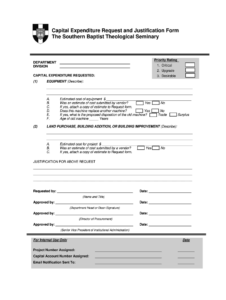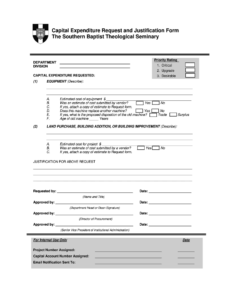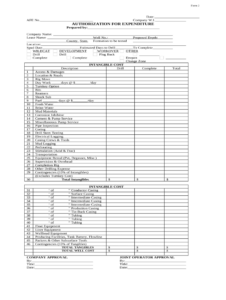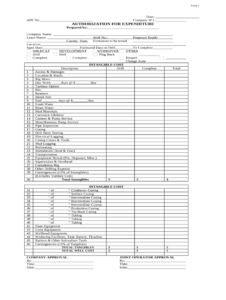Structured requests offer numerous advantages. They streamline the approval process, promote transparency, and encourage thoughtful planning of resource allocation. By standardizing the information gathered, these forms improve decision-making and reduce the likelihood of costly oversights. They contribute to better budget control and facilitate more effective tracking of investment performance over time.
The following sections delve deeper into specific components of these crucial financial documents, offering practical guidance for creating, submitting, and managing them effectively. Topics covered include detailed explanations of required fields, best practices for justification and return-on-investment calculations, and strategies for navigating the approval workflow.
Key Components of a Capital Expenditure Request
Effective requests for funding substantial investments require detailed and structured information. The following components ensure clarity, facilitate thorough evaluation, and contribute to informed decision-making.
1. Project Title and Description: A concise, descriptive title and a brief overview of the proposed investment are essential for clear identification and initial understanding.
2. Justification and Strategic Alignment: A clear explanation of the investment’s purpose and how it aligns with organizational goals demonstrates strategic relevance and provides context for evaluation.
3. Cost Breakdown and Budget: A detailed breakdown of all anticipated costs, including initial investment, ongoing maintenance, and potential future expenses, allows for accurate assessment of financial impact.
4. Return on Investment (ROI) Analysis: Projected financial returns, including metrics such as payback period and net present value, provide quantifiable measures of the investment’s potential value.
5. Risk Assessment and Mitigation Strategies: Identifying potential risks associated with the investment and outlining plans to mitigate them demonstrates prudent planning and proactive risk management.
6. Implementation Timeline and Milestones: A clear schedule outlining key milestones and expected completion dates ensures accountability and facilitates progress tracking.
7. Department and Sponsor Information: Identifying the requesting department and responsible individuals establishes clear ownership and lines of communication.
8. Supporting Documentation: Relevant supporting materials, such as vendor quotes, market research, or technical specifications, provide further substantiation and strengthen the request.
Comprehensive documentation of these elements enables effective assessment and prioritization of requests, ultimately contributing to responsible resource allocation and sound investment decisions.
How to Create a Capital Expenditure Request Template
Creating a standardized template ensures consistency and efficiency in the capital expenditure request process. A well-designed template guides requesters in providing comprehensive information, facilitating thorough evaluations and informed decision-making.
1: Define Objectives: Clearly outline the purpose of the template and the types of capital expenditures it should cover. This establishes the scope and ensures relevance to organizational needs.
2: Determine Required Information: Identify the essential information needed for thorough evaluation, including project details, justification, budget, ROI analysis, risk assessment, and timelines.
3: Design the Template Structure: Organize the template logically with clear sections and headings. Use a consistent format for data entry, such as tables or specific fields, to promote clarity and ease of use.
4: Incorporate Approval Workflows: Integrate designated approval levels and routing procedures within the template to streamline the review and approval process. This ensures accountability and efficient tracking.
5: Develop Instructions and Guidance: Provide clear instructions and examples for completing each section of the template. This minimizes ambiguity and improves the quality of submitted requests.
6: Implement and Train: Introduce the template to relevant personnel and provide training on its use. This ensures consistent application and maximizes the benefits of standardization.
7: Review and Refine: Periodically review the template’s effectiveness and gather feedback from users. Make necessary adjustments to optimize its functionality and maintain relevance to evolving organizational requirements.
A well-structured template provides a framework for consistent and comprehensive capital expenditure requests, fostering effective resource allocation and supporting strategic investment decisions.
Standardized forms for requesting capital expenditures provide a crucial framework for organizations to evaluate and prioritize investments in fixed assets. These structured templates ensure consistent presentation of essential information, including project justification, cost analysis, return on investment projections, and risk assessment. By streamlining the request process and promoting transparency, organizations can make more informed decisions about resource allocation, ultimately contributing to long-term financial stability and strategic growth.
Effective management of capital expenditures requires a disciplined approach and a commitment to continuous improvement. Organizations should regularly review and refine their processes, incorporating best practices and adapting to evolving business needs. By prioritizing thoughtful planning and rigorous evaluation, organizations can maximize the value of their investments and ensure alignment with overall strategic objectives.



